MIS770 - Data Analysis of Car Insurance Industry - Data Skills
VerifiedAdded on 2022/11/25
|10
|2527
|91
Report
AI Summary
This report analyzes a dataset from the car insurance industry to understand patterns related to brokering services, customer demographics, and average savings. Statistical methods are applied to assess broker performance, customer satisfaction levels (urban vs. rural, male vs. female), and the relationship between various parameters (car value, car age, license held) and insurance premiums. The analysis estimates population parameters such as average savings and the proportion of people with comprehensive insurance, considering a margin of error. Key findings include a decrease in average savings over recent years, no significant difference in performance among the four brokers, and a positive correlation between car value and insurance premium, while car age is negatively correlated. The report also evaluates claims regarding gender differences in availing brokering services, finding no statistical support for the assertion that men are less likely to use brokers.
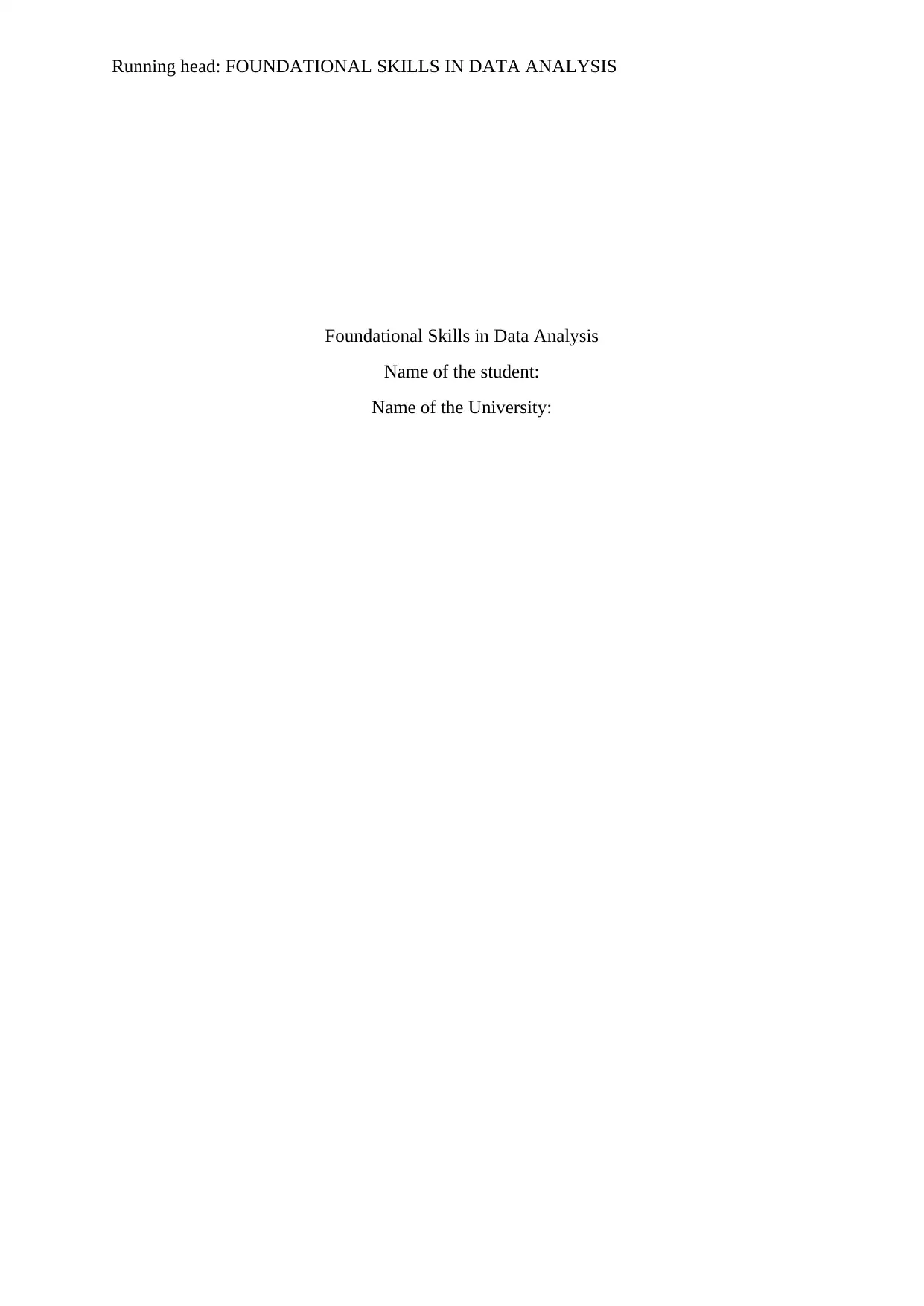
Running head: FOUNDATIONAL SKILLS IN DATA ANALYSIS
Foundational Skills in Data Analysis
Name of the student:
Name of the University:
Foundational Skills in Data Analysis
Name of the student:
Name of the University:
Paraphrase This Document
Need a fresh take? Get an instant paraphrase of this document with our AI Paraphraser
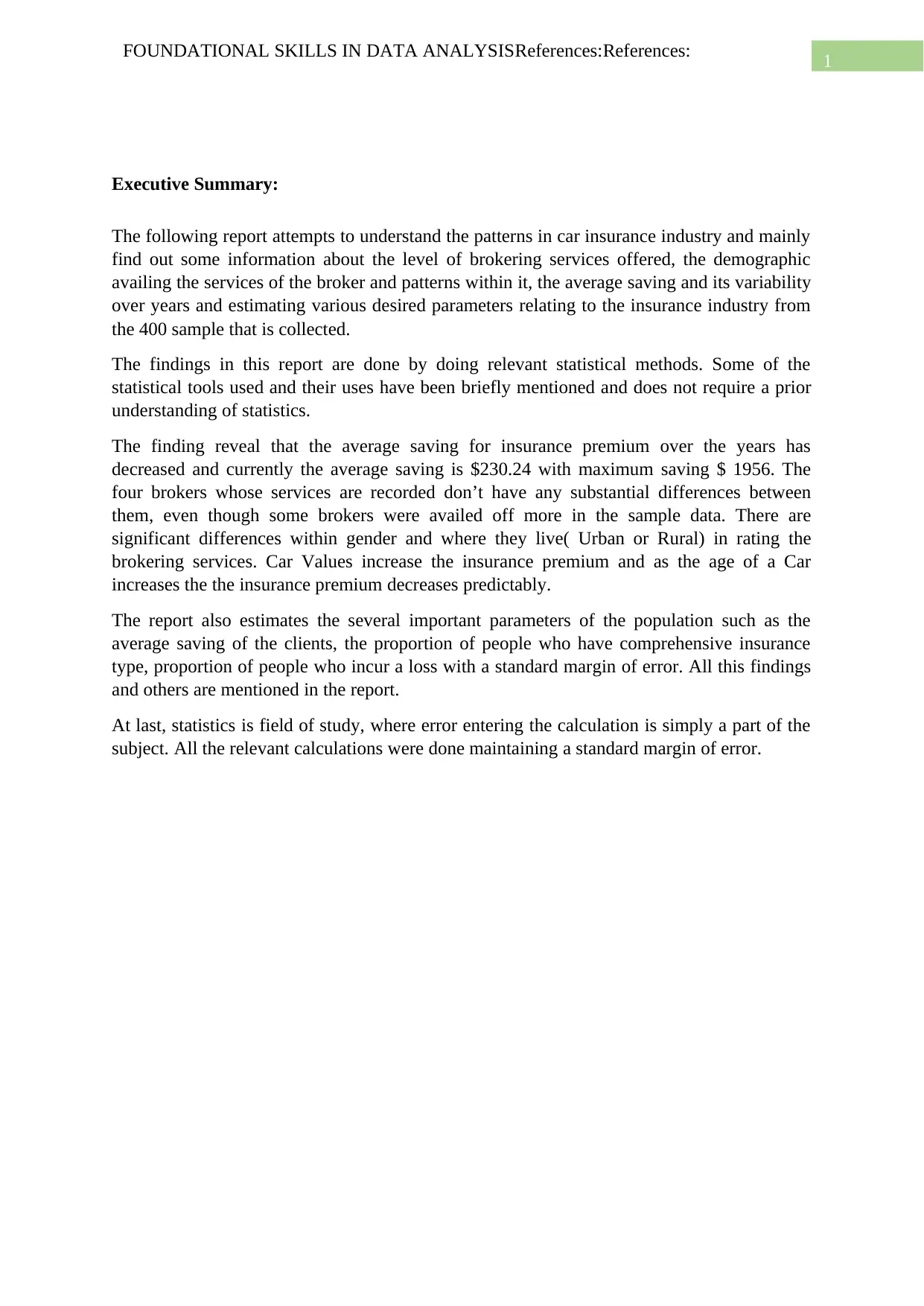
1
FOUNDATIONAL SKILLS IN DATA ANALYSISReferences:References:
Executive Summary:
The following report attempts to understand the patterns in car insurance industry and mainly
find out some information about the level of brokering services offered, the demographic
availing the services of the broker and patterns within it, the average saving and its variability
over years and estimating various desired parameters relating to the insurance industry from
the 400 sample that is collected.
The findings in this report are done by doing relevant statistical methods. Some of the
statistical tools used and their uses have been briefly mentioned and does not require a prior
understanding of statistics.
The finding reveal that the average saving for insurance premium over the years has
decreased and currently the average saving is $230.24 with maximum saving $ 1956. The
four brokers whose services are recorded don’t have any substantial differences between
them, even though some brokers were availed off more in the sample data. There are
significant differences within gender and where they live( Urban or Rural) in rating the
brokering services. Car Values increase the insurance premium and as the age of a Car
increases the the insurance premium decreases predictably.
The report also estimates the several important parameters of the population such as the
average saving of the clients, the proportion of people who have comprehensive insurance
type, proportion of people who incur a loss with a standard margin of error. All this findings
and others are mentioned in the report.
At last, statistics is field of study, where error entering the calculation is simply a part of the
subject. All the relevant calculations were done maintaining a standard margin of error.
FOUNDATIONAL SKILLS IN DATA ANALYSISReferences:References:
Executive Summary:
The following report attempts to understand the patterns in car insurance industry and mainly
find out some information about the level of brokering services offered, the demographic
availing the services of the broker and patterns within it, the average saving and its variability
over years and estimating various desired parameters relating to the insurance industry from
the 400 sample that is collected.
The findings in this report are done by doing relevant statistical methods. Some of the
statistical tools used and their uses have been briefly mentioned and does not require a prior
understanding of statistics.
The finding reveal that the average saving for insurance premium over the years has
decreased and currently the average saving is $230.24 with maximum saving $ 1956. The
four brokers whose services are recorded don’t have any substantial differences between
them, even though some brokers were availed off more in the sample data. There are
significant differences within gender and where they live( Urban or Rural) in rating the
brokering services. Car Values increase the insurance premium and as the age of a Car
increases the the insurance premium decreases predictably.
The report also estimates the several important parameters of the population such as the
average saving of the clients, the proportion of people who have comprehensive insurance
type, proportion of people who incur a loss with a standard margin of error. All this findings
and others are mentioned in the report.
At last, statistics is field of study, where error entering the calculation is simply a part of the
subject. All the relevant calculations were done maintaining a standard margin of error.

2
FOUNDATIONAL SKILLS IN DATA ANALYSISReferences:References:
FOUNDATIONAL SKILLS IN DATA ANALYSISReferences:References:
⊘ This is a preview!⊘
Do you want full access?
Subscribe today to unlock all pages.

Trusted by 1+ million students worldwide
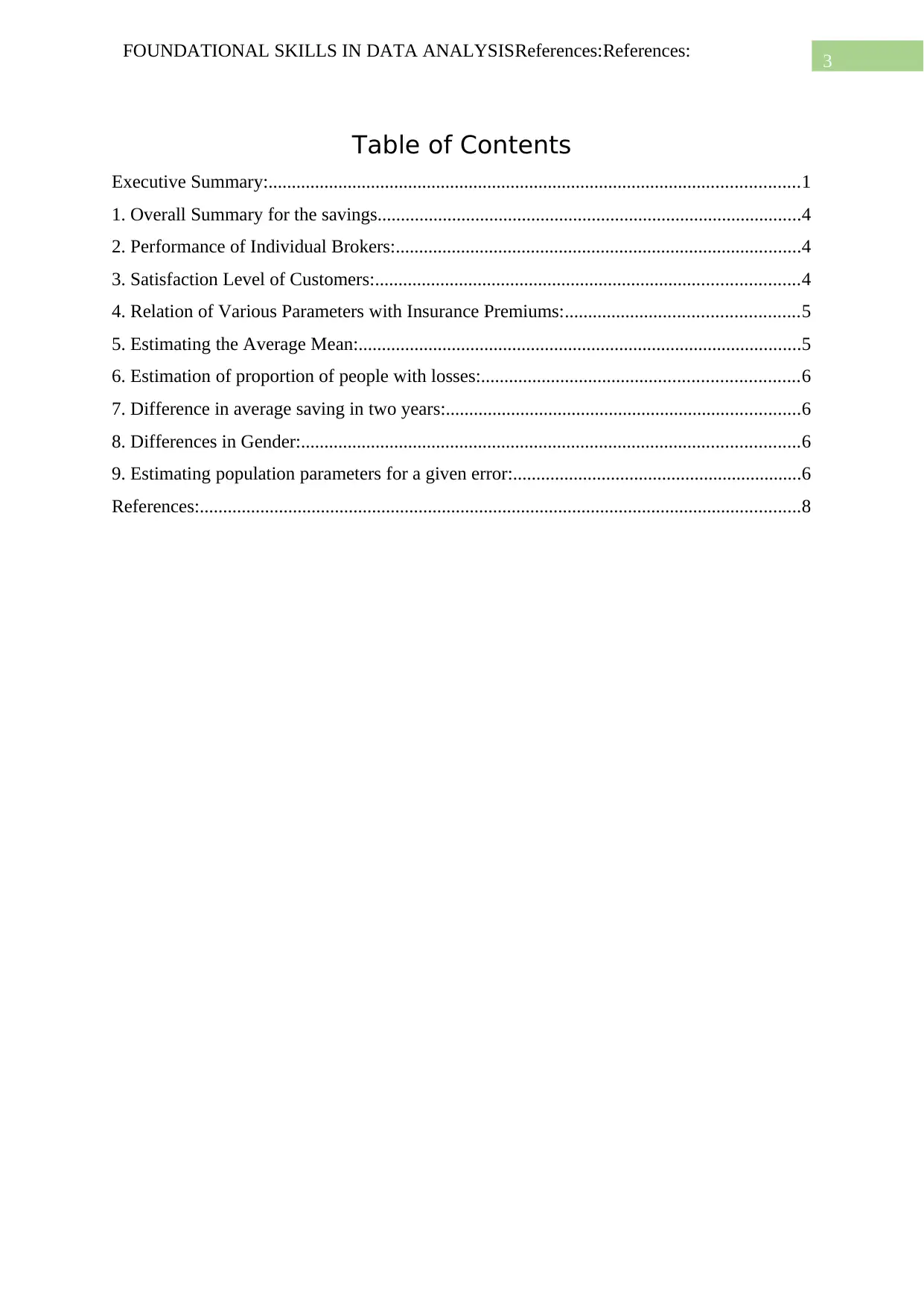
3
FOUNDATIONAL SKILLS IN DATA ANALYSISReferences:References:
Table of Contents
Executive Summary:..................................................................................................................1
1. Overall Summary for the savings...........................................................................................4
2. Performance of Individual Brokers:.......................................................................................4
3. Satisfaction Level of Customers:...........................................................................................4
4. Relation of Various Parameters with Insurance Premiums:..................................................5
5. Estimating the Average Mean:...............................................................................................5
6. Estimation of proportion of people with losses:....................................................................6
7. Difference in average saving in two years:............................................................................6
8. Differences in Gender:...........................................................................................................6
9. Estimating population parameters for a given error:..............................................................6
References:.................................................................................................................................8
FOUNDATIONAL SKILLS IN DATA ANALYSISReferences:References:
Table of Contents
Executive Summary:..................................................................................................................1
1. Overall Summary for the savings...........................................................................................4
2. Performance of Individual Brokers:.......................................................................................4
3. Satisfaction Level of Customers:...........................................................................................4
4. Relation of Various Parameters with Insurance Premiums:..................................................5
5. Estimating the Average Mean:...............................................................................................5
6. Estimation of proportion of people with losses:....................................................................6
7. Difference in average saving in two years:............................................................................6
8. Differences in Gender:...........................................................................................................6
9. Estimating population parameters for a given error:..............................................................6
References:.................................................................................................................................8
Paraphrase This Document
Need a fresh take? Get an instant paraphrase of this document with our AI Paraphraser
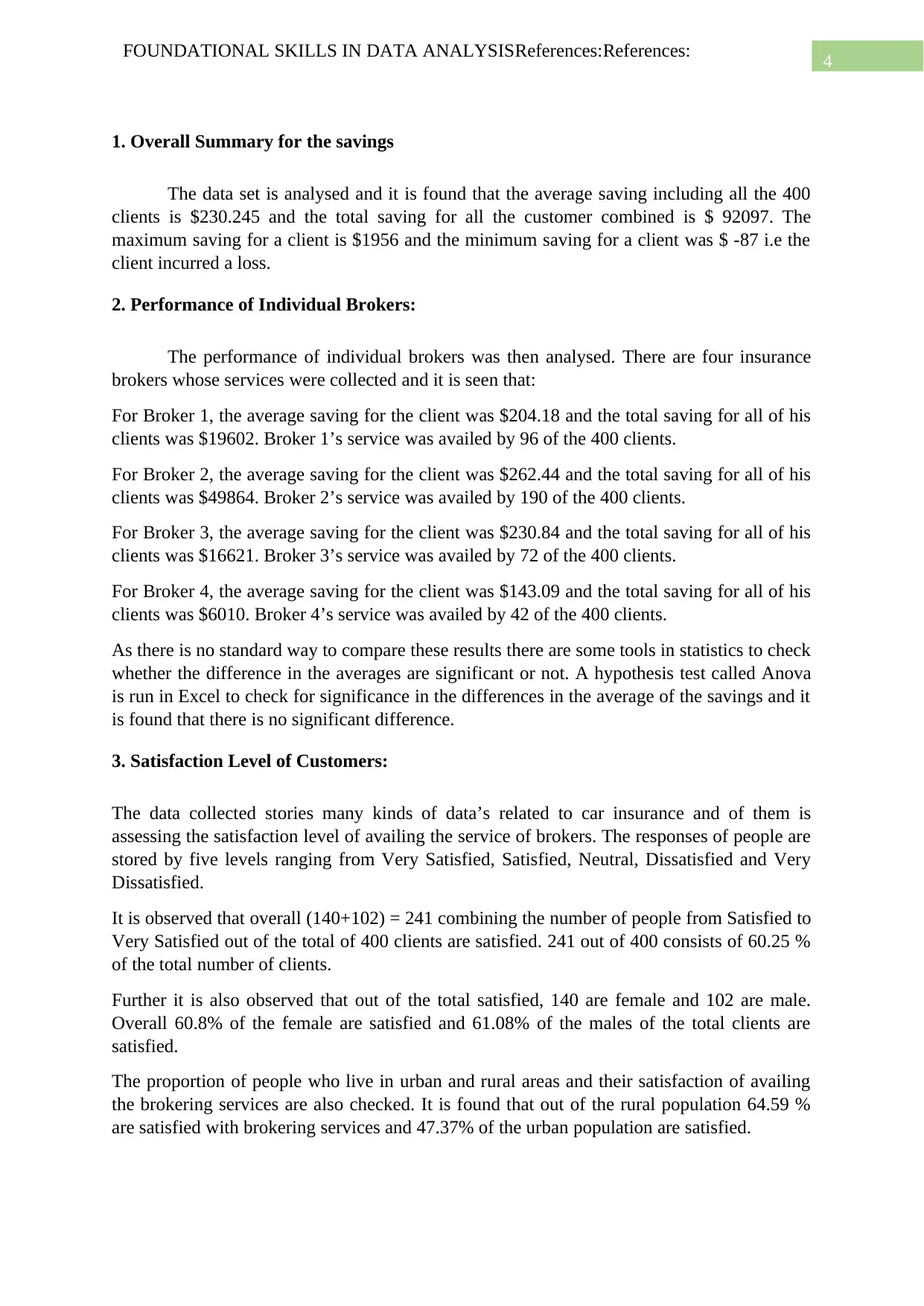
4
FOUNDATIONAL SKILLS IN DATA ANALYSISReferences:References:
1. Overall Summary for the savings
The data set is analysed and it is found that the average saving including all the 400
clients is $230.245 and the total saving for all the customer combined is $ 92097. The
maximum saving for a client is $1956 and the minimum saving for a client was $ -87 i.e the
client incurred a loss.
2. Performance of Individual Brokers:
The performance of individual brokers was then analysed. There are four insurance
brokers whose services were collected and it is seen that:
For Broker 1, the average saving for the client was $204.18 and the total saving for all of his
clients was $19602. Broker 1’s service was availed by 96 of the 400 clients.
For Broker 2, the average saving for the client was $262.44 and the total saving for all of his
clients was $49864. Broker 2’s service was availed by 190 of the 400 clients.
For Broker 3, the average saving for the client was $230.84 and the total saving for all of his
clients was $16621. Broker 3’s service was availed by 72 of the 400 clients.
For Broker 4, the average saving for the client was $143.09 and the total saving for all of his
clients was $6010. Broker 4’s service was availed by 42 of the 400 clients.
As there is no standard way to compare these results there are some tools in statistics to check
whether the difference in the averages are significant or not. A hypothesis test called Anova
is run in Excel to check for significance in the differences in the average of the savings and it
is found that there is no significant difference.
3. Satisfaction Level of Customers:
The data collected stories many kinds of data’s related to car insurance and of them is
assessing the satisfaction level of availing the service of brokers. The responses of people are
stored by five levels ranging from Very Satisfied, Satisfied, Neutral, Dissatisfied and Very
Dissatisfied.
It is observed that overall (140+102) = 241 combining the number of people from Satisfied to
Very Satisfied out of the total of 400 clients are satisfied. 241 out of 400 consists of 60.25 %
of the total number of clients.
Further it is also observed that out of the total satisfied, 140 are female and 102 are male.
Overall 60.8% of the female are satisfied and 61.08% of the males of the total clients are
satisfied.
The proportion of people who live in urban and rural areas and their satisfaction of availing
the brokering services are also checked. It is found that out of the rural population 64.59 %
are satisfied with brokering services and 47.37% of the urban population are satisfied.
FOUNDATIONAL SKILLS IN DATA ANALYSISReferences:References:
1. Overall Summary for the savings
The data set is analysed and it is found that the average saving including all the 400
clients is $230.245 and the total saving for all the customer combined is $ 92097. The
maximum saving for a client is $1956 and the minimum saving for a client was $ -87 i.e the
client incurred a loss.
2. Performance of Individual Brokers:
The performance of individual brokers was then analysed. There are four insurance
brokers whose services were collected and it is seen that:
For Broker 1, the average saving for the client was $204.18 and the total saving for all of his
clients was $19602. Broker 1’s service was availed by 96 of the 400 clients.
For Broker 2, the average saving for the client was $262.44 and the total saving for all of his
clients was $49864. Broker 2’s service was availed by 190 of the 400 clients.
For Broker 3, the average saving for the client was $230.84 and the total saving for all of his
clients was $16621. Broker 3’s service was availed by 72 of the 400 clients.
For Broker 4, the average saving for the client was $143.09 and the total saving for all of his
clients was $6010. Broker 4’s service was availed by 42 of the 400 clients.
As there is no standard way to compare these results there are some tools in statistics to check
whether the difference in the averages are significant or not. A hypothesis test called Anova
is run in Excel to check for significance in the differences in the average of the savings and it
is found that there is no significant difference.
3. Satisfaction Level of Customers:
The data collected stories many kinds of data’s related to car insurance and of them is
assessing the satisfaction level of availing the service of brokers. The responses of people are
stored by five levels ranging from Very Satisfied, Satisfied, Neutral, Dissatisfied and Very
Dissatisfied.
It is observed that overall (140+102) = 241 combining the number of people from Satisfied to
Very Satisfied out of the total of 400 clients are satisfied. 241 out of 400 consists of 60.25 %
of the total number of clients.
Further it is also observed that out of the total satisfied, 140 are female and 102 are male.
Overall 60.8% of the female are satisfied and 61.08% of the males of the total clients are
satisfied.
The proportion of people who live in urban and rural areas and their satisfaction of availing
the brokering services are also checked. It is found that out of the rural population 64.59 %
are satisfied with brokering services and 47.37% of the urban population are satisfied.
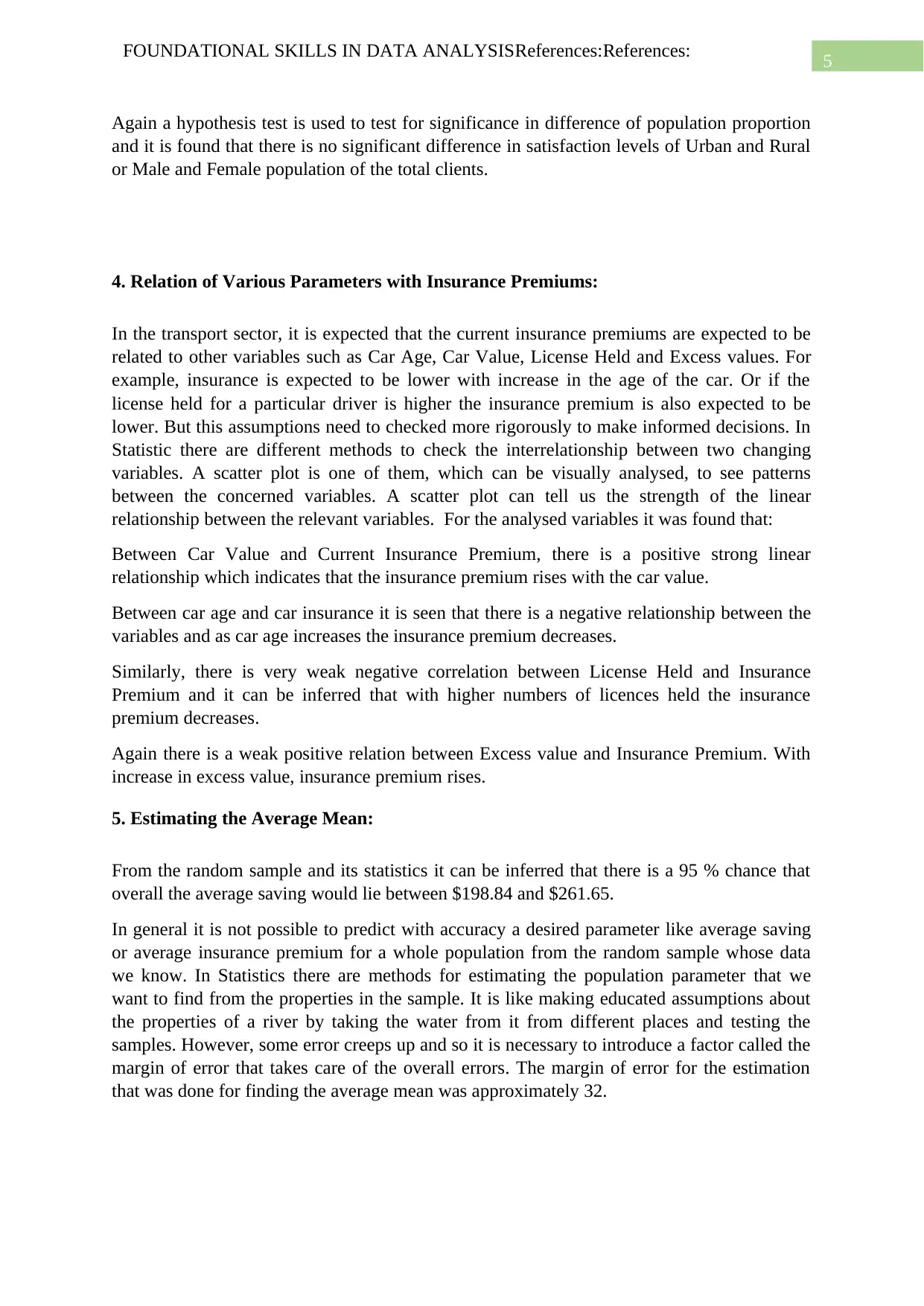
5
FOUNDATIONAL SKILLS IN DATA ANALYSISReferences:References:
Again a hypothesis test is used to test for significance in difference of population proportion
and it is found that there is no significant difference in satisfaction levels of Urban and Rural
or Male and Female population of the total clients.
4. Relation of Various Parameters with Insurance Premiums:
In the transport sector, it is expected that the current insurance premiums are expected to be
related to other variables such as Car Age, Car Value, License Held and Excess values. For
example, insurance is expected to be lower with increase in the age of the car. Or if the
license held for a particular driver is higher the insurance premium is also expected to be
lower. But this assumptions need to checked more rigorously to make informed decisions. In
Statistic there are different methods to check the interrelationship between two changing
variables. A scatter plot is one of them, which can be visually analysed, to see patterns
between the concerned variables. A scatter plot can tell us the strength of the linear
relationship between the relevant variables. For the analysed variables it was found that:
Between Car Value and Current Insurance Premium, there is a positive strong linear
relationship which indicates that the insurance premium rises with the car value.
Between car age and car insurance it is seen that there is a negative relationship between the
variables and as car age increases the insurance premium decreases.
Similarly, there is very weak negative correlation between License Held and Insurance
Premium and it can be inferred that with higher numbers of licences held the insurance
premium decreases.
Again there is a weak positive relation between Excess value and Insurance Premium. With
increase in excess value, insurance premium rises.
5. Estimating the Average Mean:
From the random sample and its statistics it can be inferred that there is a 95 % chance that
overall the average saving would lie between $198.84 and $261.65.
In general it is not possible to predict with accuracy a desired parameter like average saving
or average insurance premium for a whole population from the random sample whose data
we know. In Statistics there are methods for estimating the population parameter that we
want to find from the properties in the sample. It is like making educated assumptions about
the properties of a river by taking the water from it from different places and testing the
samples. However, some error creeps up and so it is necessary to introduce a factor called the
margin of error that takes care of the overall errors. The margin of error for the estimation
that was done for finding the average mean was approximately 32.
FOUNDATIONAL SKILLS IN DATA ANALYSISReferences:References:
Again a hypothesis test is used to test for significance in difference of population proportion
and it is found that there is no significant difference in satisfaction levels of Urban and Rural
or Male and Female population of the total clients.
4. Relation of Various Parameters with Insurance Premiums:
In the transport sector, it is expected that the current insurance premiums are expected to be
related to other variables such as Car Age, Car Value, License Held and Excess values. For
example, insurance is expected to be lower with increase in the age of the car. Or if the
license held for a particular driver is higher the insurance premium is also expected to be
lower. But this assumptions need to checked more rigorously to make informed decisions. In
Statistic there are different methods to check the interrelationship between two changing
variables. A scatter plot is one of them, which can be visually analysed, to see patterns
between the concerned variables. A scatter plot can tell us the strength of the linear
relationship between the relevant variables. For the analysed variables it was found that:
Between Car Value and Current Insurance Premium, there is a positive strong linear
relationship which indicates that the insurance premium rises with the car value.
Between car age and car insurance it is seen that there is a negative relationship between the
variables and as car age increases the insurance premium decreases.
Similarly, there is very weak negative correlation between License Held and Insurance
Premium and it can be inferred that with higher numbers of licences held the insurance
premium decreases.
Again there is a weak positive relation between Excess value and Insurance Premium. With
increase in excess value, insurance premium rises.
5. Estimating the Average Mean:
From the random sample and its statistics it can be inferred that there is a 95 % chance that
overall the average saving would lie between $198.84 and $261.65.
In general it is not possible to predict with accuracy a desired parameter like average saving
or average insurance premium for a whole population from the random sample whose data
we know. In Statistics there are methods for estimating the population parameter that we
want to find from the properties in the sample. It is like making educated assumptions about
the properties of a river by taking the water from it from different places and testing the
samples. However, some error creeps up and so it is necessary to introduce a factor called the
margin of error that takes care of the overall errors. The margin of error for the estimation
that was done for finding the average mean was approximately 32.
⊘ This is a preview!⊘
Do you want full access?
Subscribe today to unlock all pages.

Trusted by 1+ million students worldwide
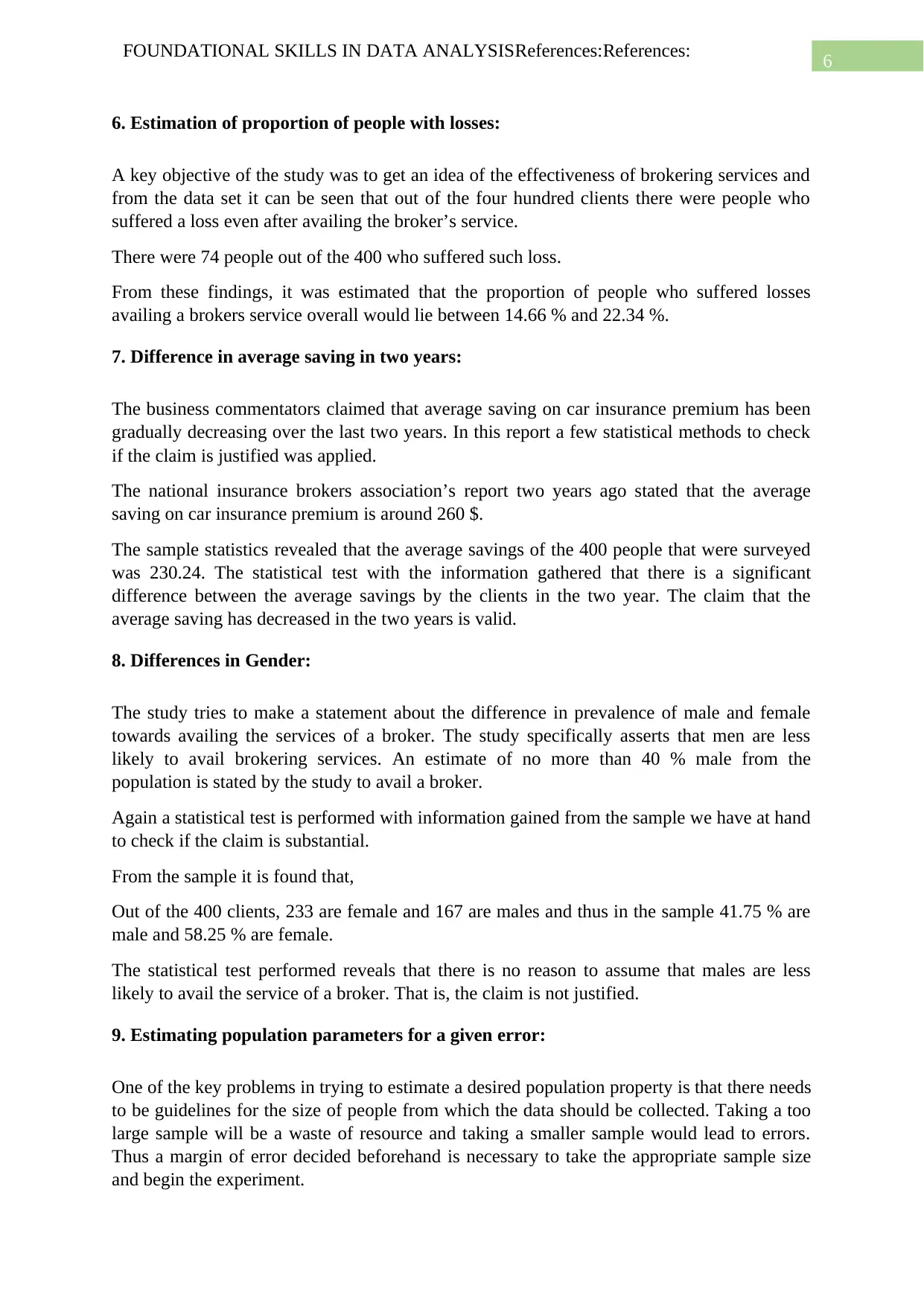
6
FOUNDATIONAL SKILLS IN DATA ANALYSISReferences:References:
6. Estimation of proportion of people with losses:
A key objective of the study was to get an idea of the effectiveness of brokering services and
from the data set it can be seen that out of the four hundred clients there were people who
suffered a loss even after availing the broker’s service.
There were 74 people out of the 400 who suffered such loss.
From these findings, it was estimated that the proportion of people who suffered losses
availing a brokers service overall would lie between 14.66 % and 22.34 %.
7. Difference in average saving in two years:
The business commentators claimed that average saving on car insurance premium has been
gradually decreasing over the last two years. In this report a few statistical methods to check
if the claim is justified was applied.
The national insurance brokers association’s report two years ago stated that the average
saving on car insurance premium is around 260 $.
The sample statistics revealed that the average savings of the 400 people that were surveyed
was 230.24. The statistical test with the information gathered that there is a significant
difference between the average savings by the clients in the two year. The claim that the
average saving has decreased in the two years is valid.
8. Differences in Gender:
The study tries to make a statement about the difference in prevalence of male and female
towards availing the services of a broker. The study specifically asserts that men are less
likely to avail brokering services. An estimate of no more than 40 % male from the
population is stated by the study to avail a broker.
Again a statistical test is performed with information gained from the sample we have at hand
to check if the claim is substantial.
From the sample it is found that,
Out of the 400 clients, 233 are female and 167 are males and thus in the sample 41.75 % are
male and 58.25 % are female.
The statistical test performed reveals that there is no reason to assume that males are less
likely to avail the service of a broker. That is, the claim is not justified.
9. Estimating population parameters for a given error:
One of the key problems in trying to estimate a desired population property is that there needs
to be guidelines for the size of people from which the data should be collected. Taking a too
large sample will be a waste of resource and taking a smaller sample would lead to errors.
Thus a margin of error decided beforehand is necessary to take the appropriate sample size
and begin the experiment.
FOUNDATIONAL SKILLS IN DATA ANALYSISReferences:References:
6. Estimation of proportion of people with losses:
A key objective of the study was to get an idea of the effectiveness of brokering services and
from the data set it can be seen that out of the four hundred clients there were people who
suffered a loss even after availing the broker’s service.
There were 74 people out of the 400 who suffered such loss.
From these findings, it was estimated that the proportion of people who suffered losses
availing a brokers service overall would lie between 14.66 % and 22.34 %.
7. Difference in average saving in two years:
The business commentators claimed that average saving on car insurance premium has been
gradually decreasing over the last two years. In this report a few statistical methods to check
if the claim is justified was applied.
The national insurance brokers association’s report two years ago stated that the average
saving on car insurance premium is around 260 $.
The sample statistics revealed that the average savings of the 400 people that were surveyed
was 230.24. The statistical test with the information gathered that there is a significant
difference between the average savings by the clients in the two year. The claim that the
average saving has decreased in the two years is valid.
8. Differences in Gender:
The study tries to make a statement about the difference in prevalence of male and female
towards availing the services of a broker. The study specifically asserts that men are less
likely to avail brokering services. An estimate of no more than 40 % male from the
population is stated by the study to avail a broker.
Again a statistical test is performed with information gained from the sample we have at hand
to check if the claim is substantial.
From the sample it is found that,
Out of the 400 clients, 233 are female and 167 are males and thus in the sample 41.75 % are
male and 58.25 % are female.
The statistical test performed reveals that there is no reason to assume that males are less
likely to avail the service of a broker. That is, the claim is not justified.
9. Estimating population parameters for a given error:
One of the key problems in trying to estimate a desired population property is that there needs
to be guidelines for the size of people from which the data should be collected. Taking a too
large sample will be a waste of resource and taking a smaller sample would lead to errors.
Thus a margin of error decided beforehand is necessary to take the appropriate sample size
and begin the experiment.
Paraphrase This Document
Need a fresh take? Get an instant paraphrase of this document with our AI Paraphraser
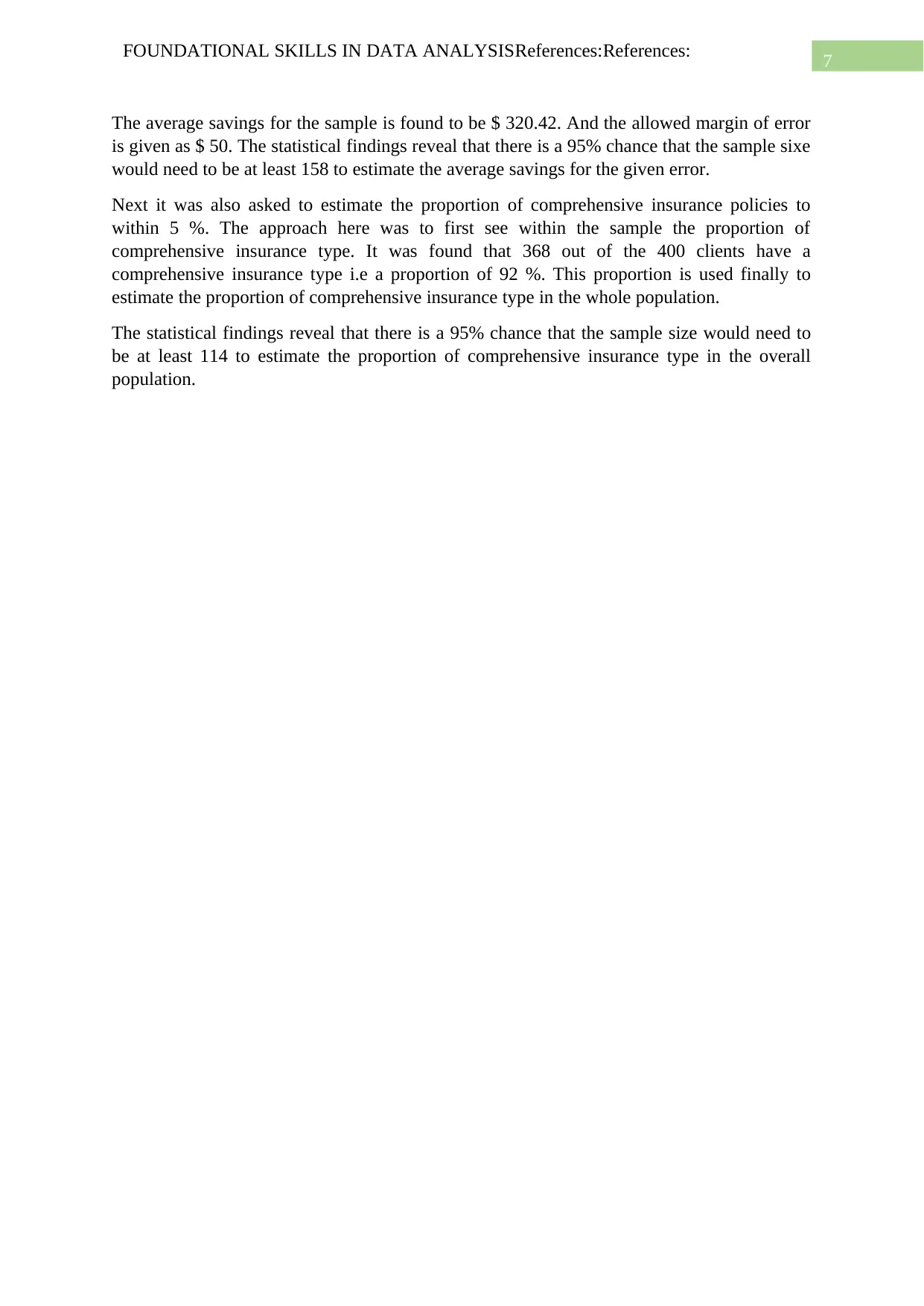
7
FOUNDATIONAL SKILLS IN DATA ANALYSISReferences:References:
The average savings for the sample is found to be $ 320.42. And the allowed margin of error
is given as $ 50. The statistical findings reveal that there is a 95% chance that the sample sixe
would need to be at least 158 to estimate the average savings for the given error.
Next it was also asked to estimate the proportion of comprehensive insurance policies to
within 5 %. The approach here was to first see within the sample the proportion of
comprehensive insurance type. It was found that 368 out of the 400 clients have a
comprehensive insurance type i.e a proportion of 92 %. This proportion is used finally to
estimate the proportion of comprehensive insurance type in the whole population.
The statistical findings reveal that there is a 95% chance that the sample size would need to
be at least 114 to estimate the proportion of comprehensive insurance type in the overall
population.
FOUNDATIONAL SKILLS IN DATA ANALYSISReferences:References:
The average savings for the sample is found to be $ 320.42. And the allowed margin of error
is given as $ 50. The statistical findings reveal that there is a 95% chance that the sample sixe
would need to be at least 158 to estimate the average savings for the given error.
Next it was also asked to estimate the proportion of comprehensive insurance policies to
within 5 %. The approach here was to first see within the sample the proportion of
comprehensive insurance type. It was found that 368 out of the 400 clients have a
comprehensive insurance type i.e a proportion of 92 %. This proportion is used finally to
estimate the proportion of comprehensive insurance type in the whole population.
The statistical findings reveal that there is a 95% chance that the sample size would need to
be at least 114 to estimate the proportion of comprehensive insurance type in the overall
population.
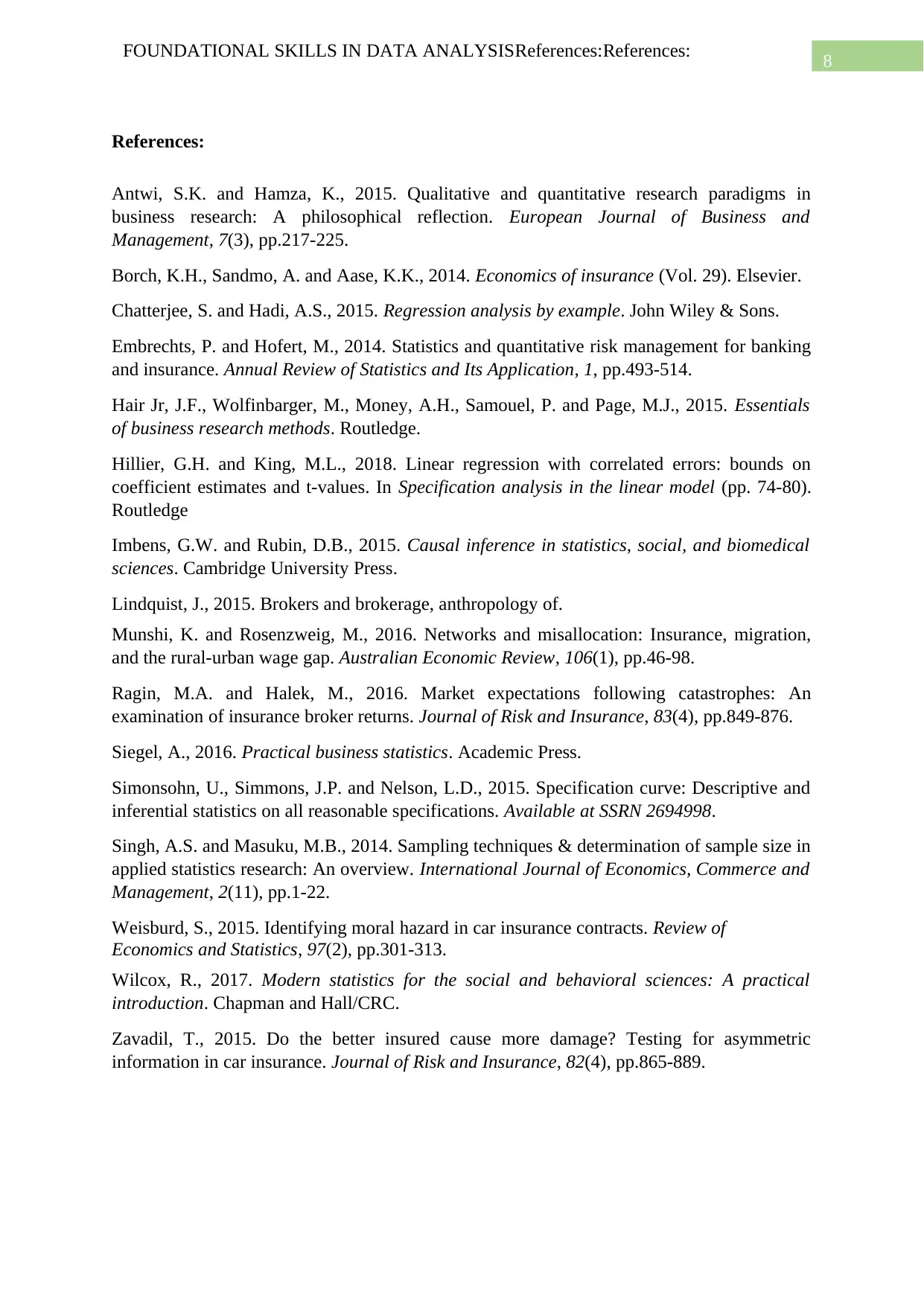
8
FOUNDATIONAL SKILLS IN DATA ANALYSISReferences:References:
References:
Antwi, S.K. and Hamza, K., 2015. Qualitative and quantitative research paradigms in
business research: A philosophical reflection. European Journal of Business and
Management, 7(3), pp.217-225.
Borch, K.H., Sandmo, A. and Aase, K.K., 2014. Economics of insurance (Vol. 29). Elsevier.
Chatterjee, S. and Hadi, A.S., 2015. Regression analysis by example. John Wiley & Sons.
Embrechts, P. and Hofert, M., 2014. Statistics and quantitative risk management for banking
and insurance. Annual Review of Statistics and Its Application, 1, pp.493-514.
Hair Jr, J.F., Wolfinbarger, M., Money, A.H., Samouel, P. and Page, M.J., 2015. Essentials
of business research methods. Routledge.
Hillier, G.H. and King, M.L., 2018. Linear regression with correlated errors: bounds on
coefficient estimates and t-values. In Specification analysis in the linear model (pp. 74-80).
Routledge
Imbens, G.W. and Rubin, D.B., 2015. Causal inference in statistics, social, and biomedical
sciences. Cambridge University Press.
Lindquist, J., 2015. Brokers and brokerage, anthropology of.
Munshi, K. and Rosenzweig, M., 2016. Networks and misallocation: Insurance, migration,
and the rural-urban wage gap. Australian Economic Review, 106(1), pp.46-98.
Ragin, M.A. and Halek, M., 2016. Market expectations following catastrophes: An
examination of insurance broker returns. Journal of Risk and Insurance, 83(4), pp.849-876.
Siegel, A., 2016. Practical business statistics. Academic Press.
Simonsohn, U., Simmons, J.P. and Nelson, L.D., 2015. Specification curve: Descriptive and
inferential statistics on all reasonable specifications. Available at SSRN 2694998.
Singh, A.S. and Masuku, M.B., 2014. Sampling techniques & determination of sample size in
applied statistics research: An overview. International Journal of Economics, Commerce and
Management, 2(11), pp.1-22.
Weisburd, S., 2015. Identifying moral hazard in car insurance contracts. Review of
Economics and Statistics, 97(2), pp.301-313.
Wilcox, R., 2017. Modern statistics for the social and behavioral sciences: A practical
introduction. Chapman and Hall/CRC.
Zavadil, T., 2015. Do the better insured cause more damage? Testing for asymmetric
information in car insurance. Journal of Risk and Insurance, 82(4), pp.865-889.
FOUNDATIONAL SKILLS IN DATA ANALYSISReferences:References:
References:
Antwi, S.K. and Hamza, K., 2015. Qualitative and quantitative research paradigms in
business research: A philosophical reflection. European Journal of Business and
Management, 7(3), pp.217-225.
Borch, K.H., Sandmo, A. and Aase, K.K., 2014. Economics of insurance (Vol. 29). Elsevier.
Chatterjee, S. and Hadi, A.S., 2015. Regression analysis by example. John Wiley & Sons.
Embrechts, P. and Hofert, M., 2014. Statistics and quantitative risk management for banking
and insurance. Annual Review of Statistics and Its Application, 1, pp.493-514.
Hair Jr, J.F., Wolfinbarger, M., Money, A.H., Samouel, P. and Page, M.J., 2015. Essentials
of business research methods. Routledge.
Hillier, G.H. and King, M.L., 2018. Linear regression with correlated errors: bounds on
coefficient estimates and t-values. In Specification analysis in the linear model (pp. 74-80).
Routledge
Imbens, G.W. and Rubin, D.B., 2015. Causal inference in statistics, social, and biomedical
sciences. Cambridge University Press.
Lindquist, J., 2015. Brokers and brokerage, anthropology of.
Munshi, K. and Rosenzweig, M., 2016. Networks and misallocation: Insurance, migration,
and the rural-urban wage gap. Australian Economic Review, 106(1), pp.46-98.
Ragin, M.A. and Halek, M., 2016. Market expectations following catastrophes: An
examination of insurance broker returns. Journal of Risk and Insurance, 83(4), pp.849-876.
Siegel, A., 2016. Practical business statistics. Academic Press.
Simonsohn, U., Simmons, J.P. and Nelson, L.D., 2015. Specification curve: Descriptive and
inferential statistics on all reasonable specifications. Available at SSRN 2694998.
Singh, A.S. and Masuku, M.B., 2014. Sampling techniques & determination of sample size in
applied statistics research: An overview. International Journal of Economics, Commerce and
Management, 2(11), pp.1-22.
Weisburd, S., 2015. Identifying moral hazard in car insurance contracts. Review of
Economics and Statistics, 97(2), pp.301-313.
Wilcox, R., 2017. Modern statistics for the social and behavioral sciences: A practical
introduction. Chapman and Hall/CRC.
Zavadil, T., 2015. Do the better insured cause more damage? Testing for asymmetric
information in car insurance. Journal of Risk and Insurance, 82(4), pp.865-889.
⊘ This is a preview!⊘
Do you want full access?
Subscribe today to unlock all pages.

Trusted by 1+ million students worldwide

9
FOUNDATIONAL SKILLS IN DATA ANALYSISReferences:References:
FOUNDATIONAL SKILLS IN DATA ANALYSISReferences:References:
1 out of 10
Related Documents
Your All-in-One AI-Powered Toolkit for Academic Success.
+13062052269
info@desklib.com
Available 24*7 on WhatsApp / Email
![[object Object]](/_next/static/media/star-bottom.7253800d.svg)
Unlock your academic potential
Copyright © 2020–2025 A2Z Services. All Rights Reserved. Developed and managed by ZUCOL.





